Top 5 Energy Storage Innovation Trends in 2023
The world, especially Europe, is witnessing an energy crisis. This has resulted in increased electricity prices due to its significant dependence on the natural gas supply from Russia. And even though Europe bought enough gas to survive the Winter, the issue still remains, i.e., their dependency on gas. To overcome this issue, companies are coming up with various energy storage innovations which are not just efficient but sustainable and safe way as well. In this article, we’ll discuss these innovation trends in detail.
The global energy storage market was valued at $188.5 billion in 2020. It is projected to reach $435.5 billion by 2030, growing at a CAGR of 8.3%.
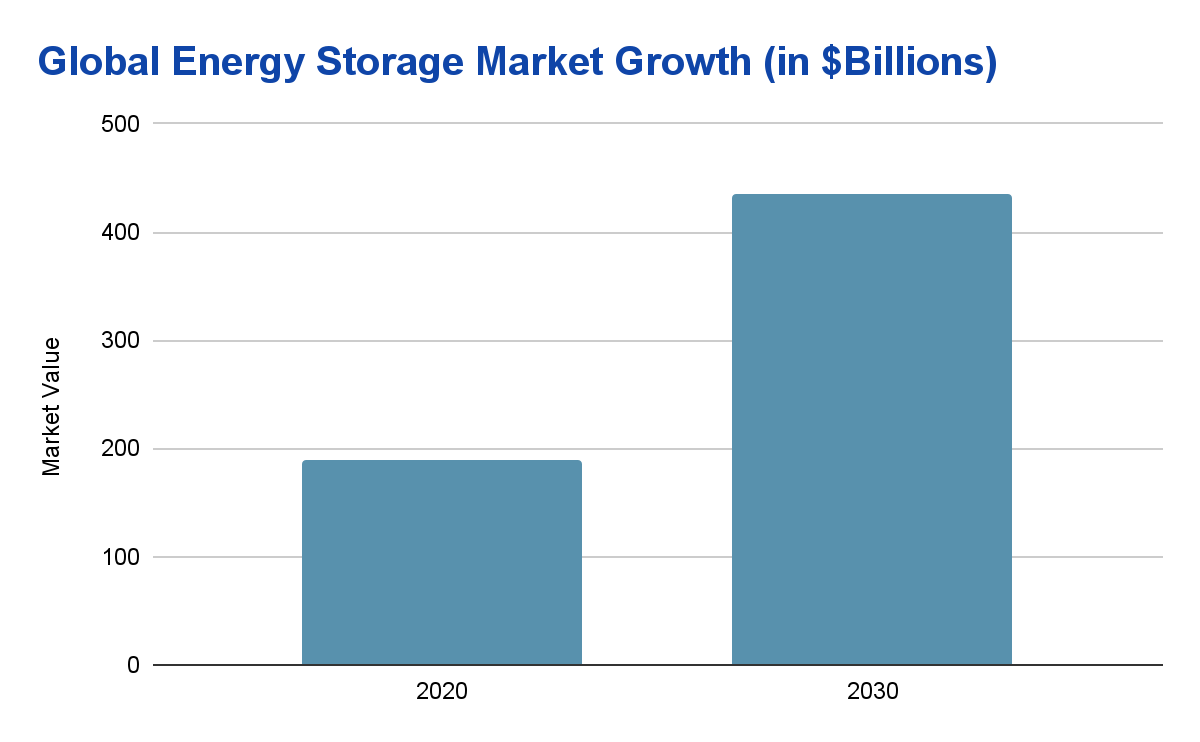
The reason for this high value in the global market is the new technological solutions that are improving and innovating the energy storage sector.
The article covers the top 5 trends from our complete study on 10 Energy Storage innovation trends. The study includes their market growth, advantage, and disadvantages. Fill out the form below to get a complete understanding of all the 10 trends delivered right to your inbox:
Here are the top 5 innovation trends in energy storage –
Trend 1: Hydrogen Energy Storage
Hydrogen Energy Storage is a type of chemical energy storage wherein electrical power is transformed into hydrogen using electrolysis. This energy is then recovered by burning the gas in a combustion engine or a fuel cell.
Hydrogen is employed in various industrial applications such as glass, fertilizer, steel, and chemical manufacturing. All of these businesses have an urgent need to reduce their carbon footprints as a result of environmental regulations and customer preferences.
The rapid industrialization of developing countries, as well as the increased adoption of alternate kinds of energy, are driving market expansion. Among the primary objectives intended by the government are the development and building of cost-effective and energy-saving hydrogen plants around the country. (Source)(Source)
In 2021, the global hydrogen energy storage market was valued at $14.69 billion, and it’s expected to grow and reach $21.64 billion by 2030. The market is expected to increase at an approximate CAGR of 4.4% during the forecasted period. (Source)
Global Hydrogen Energy Storage Market Size during 2021-2030 ($Billion)

The market potential of hydrogen energy storage systems is great, but like all solutions, it also comes with certain benefits and challenges. Let’s look into them.
Advantages of Using Hydrogen Energy Storage
Enabling greater incorporation of renewable energy generation
Collecting the renewable power inputs from RES, hydrogen, as energy, can offer fuel for creating electricity or heat or for fueling an automobile. When needed, the stored hydrogen can be used to generate electricity. It can also be used in other energy-intensive sectors like the gas grid, transportation fuel, and industrial activities. Hydrogen storage is not limited by region and can transfer limited renewable generation into other energy-intensive sectors. (Source)
Challenges of Hydrogen Energy Storage
High capital cost of the liquid
At the moment, hydrogen energy storage is more costly than fossil fuel. The majority of these hydrogen storage technologies are in the early development stages. The quantity of energy that fuel cells can create from hydrogen and then use to meet the needs of commercial and residential buildings is exceedingly low. Due to the high insulation expenses required to prevent vaporization, the market for storing hydrogen energy in liquid form has significant capital expenditures. Hence, the time and cost of charging and discharging hydrogen in these systems and the process expenses are significant.
Strict government regulations
Stringent government rules governing the production of hydrogen by electrolysis have been hindering the expansion of the worldwide hydrogen energy storage sector. The manufacture and application of hydrogen are prohibited in several areas. The manufacturing process can endanger the lives of those who work in factories. (Source)(Source)
Author’s recommendation: Read our elaborated study on hydrogen energy storage innovation trends.
Trend 2: Battery Energy Storage System
Battery Energy Storage System (BESS) is a technology that uses specifically built rechargeable batteries to store electric charge for later use. Much research has resulted in battery advancements, transforming the notion of a BESS into a commercial reality.
In this method, batteries collect electricity from the power grid, directly from the power station, or from a renewable energy source such as solar panels. They store it as current to be released when required.
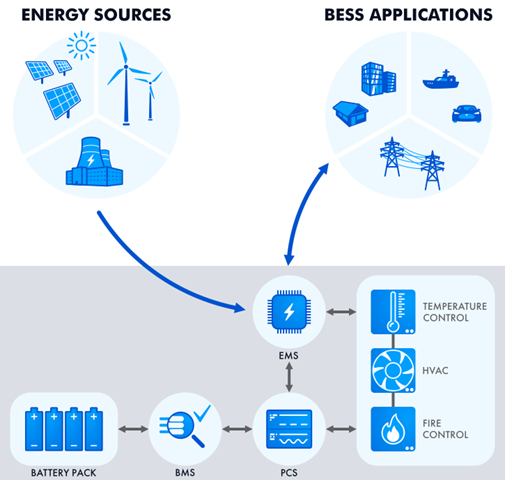
Australian and German homeowners built around 31,000 and 100,000 battery energy storage systems, respectively, by 2020. Large-scale BESSs are now operational in nations such as the US, Australia, the UK, Japan, China, and many others. Jackson Group, a Noida-based power and infrastructure corporation, introduced EnerPack, a revolutionary (BESS), in September 2021. It can minimize climate change and ensure a continuous supply of green power. (Source)(Source)
In 2021, the global battery energy storage system market was valued at $4.04 billion and is expected to increase and reach $34.72 billion by 2030. The market is expected to increase at an approximate CAGR of 27% during the forecasted period. Growing demand for power distribution energy storage systems as a result of continuous grid modernization, as well as increased consumption of lithium-ion batteries in the renewable energy market, is projected to drive battery energy storage system industry demand. (Source)
Global Battery Energy Storage System Market Size during 2021-2030 ($Billion)

Advantages of Using Battery Energy Storage System
Self-Sufficiency
Battery energy storage systems aren’t simply appealing to renewable energy providers but are also being adopted by forward-thinking enterprises. Energy purchased during off-peak hours can be stored using battery storage systems. It can be activated to distribute electricity when tariffs are at their highest, hence lowering energy expenses. Battery storage systems can also be set up to function as an uninterrupted power source. This is a useful insurance policy for enterprises.
Integration of the Grid
Renewable energy is fed directly into the grid, which is available to customers. However, grid demand swings, with highs and lows. Battery storage systems now provide a viable and cost-effective solution for medium-sized renewable energy producers to capture the electricity generated. When working with electricity, safety is critical. This is why experts install and set up the import/export controller and converter to ensure safe functioning and overload protection.
Frequency Control
Battery storage systems can control grid frequency, ensuring that it is within the needed range. The frequency can go above or below its nominal value if the power generated doesn’t match the real electricity consumption. Such inconsistencies may cause temporary disconnections, power outages, or blackouts. BESS can respond promptly to power outages, offering sub-second frequency response and grid stabilization.
Shift in Energy Time
Energy time-shifting is possible with battery energy storage systems. Energy is purchased cheaply during off-peak intervals and sold or consumed when the price rises. As a result, regardless of the season or electrical demand, BESS can equalize energy prices and reduce risks. (Source)(Source)
Challenges of Battery Energy Storage System
Installing BESS necessitates a significant capital outlay
Due to their high energy density and enhanced performance, battery energy storage technologies such as lithium-ion batteries, flow batteries, and lead-acid batteries necessitate higher installation investments. Lithium-ion batteries are expensive because they have a high energy density, a low rate of self-discharge, and need minimal maintenance. Furthermore, the high upfront investment cost necessary for flow battery manufacturing may be a key obstacle to market growth.
Installation of BESS in remote locations
Battery energy storage devices are mostly used in remote locations. These systems are challenging to deploy in remote places because they are tough to reach. Islands and off-grid distant places are common examples of remote regions that confront various issues due to fluctuating production and supply of power from renewable energy sources. Ambient circumstances such as temperature variation during the day and night, costly maintenance due to commuting problems to these sites, and a shortage of equipment installation facilities are all challenges. (Source)(Source)(Source)
Trend 3: Thermal Energy Storage
Thermal Energy Storage System (TES) is a technology that stores thermal energy by heating or chilling a storage medium so that it can be used for heating and cooling and power generation. TES devices are extremely useful in construction and industrial processes. TES is a collection of technologies that use various methods to store accessible heat energy in insulated repositories. A TES system typically consists of a tank storage medium, a compact cooler or built-up refrigeration system, pipework, pumps, and controls.
The TES system can hold vast amounts of energy safely, and its regular self-loss is minimal (0.05-1%). The reservoir has a high energy density and specific energy (80-500 W h/L, 80-250 W h/kg). The system is financially feasible with a low capital cost (3-60 $/kW h). The cycle efficiency of TES systems, on the other hand, is often low (30-60%). (Source)(Source)(Source)
In 2020, the global thermal energy storage market was valued at $20.8 billion and is expected to increase and reach $51.3 billion by 2030. The market is expected to increase at an approximate CAGR of 8.5% during the forecasted period. The COVID-19 epidemic reduced demand for thermal energy storage devices due to a global standstill in the production, construction of utility infrastructure, and renewable energy infrastructure due to government-imposed lockdown restrictions.
Global Thermal Energy Storage System Market Size during 2020-2030 ($Billion)
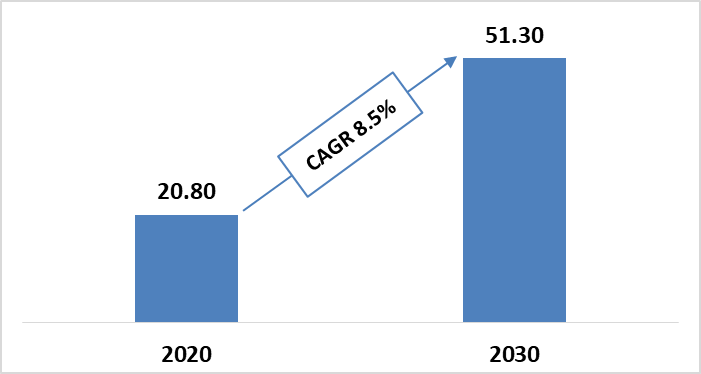
The Chinese government intended to construct 11 CSP projects incorporating thermal energy storage by 2024 January 2022. They are gigawatt-scale hybrid renewable energy projects that will be introduced within the next two years. (Source)(Source)
Advantages of Using Thermal Energy Storage System
Energy efficiency improvement
Increased energy efficiency is one of the benefits provided to power systems by thermal energy storage. District heating systems, for example, promote energy efficiency by conserving heat and then utilizing it as required. As a result, less fossil fuel is needed, and plant emissions are decreased, resulting in lower product costs. However, TES cannot deliver these advantages on its own. To contribute to improved energy management, it must be helped by intelligent control systems and information and communication technologies (ICT).
Boost generating capacity
The need for heating, cooling, or power is rarely consistent over time. The surplus production capacity available during low-demand periods can be charged to a TES to improve efficient generation capacity during high-demand periods. This procedure enables the installation of a smaller manufacturing unit, resulting in a higher load capacity for the units.
Minimal maintenance cost
Thermal storage systems have lower maintenance expenses since they use smaller chillers, cooling towers, and pumps than conventional technologies. While increasing hours of operation may somewhat negate these savings, stops and starts have a greater impact on maintenance than hours of operation. Furthermore, a conventional system often operates in a partial-load mode for most of the year, which is equally demanding maintenance as a full-load operation. (Source)(Source)(Source)(Source)
Challenges of Thermal Energy Storage System
Expensive initial setup costs
Thermal energy storage system costs vary according to application, size, and heat insulation technique. Thermal storage technologies based on phase transition materials and thermo-chemical storage are typically more expensive than the storage capacity they offer. Storage systems account for about 30% to 40% of total system costs. Latent-heat storage systems built on PCMs are predicted to cost between Є10/kWh-50/kWh ($10.7/kWh-53.5/kWh), whilst TCS expenses are expected to be between Є8/kWh-100/kWh ($8.56/kWh-107/kWh). The economic feasibility of a TES is strongly dependent on application and operation requirements, such as the quantity and frequency of storage cycles.
Boosted competition from pumped storage and battery storage
Understanding the benefits of battery and thermal energy storage is critical for utilities and power plant managers. Batteries are excellent for providing standby power for lights, elevators, and computers. Whereas thermal energy storage is the simplest approach for a structure to reduce peak electric consumption. Most battery storage projects developed by system operators (ISOs/RTOs) are for short-term energy storage and are not designed to replace the existing grid. The majority of these installations employ lithium-ion batteries, which produce enough energy to power the local grid for 4 hours or fewer. Even though thermal energy storage requires lower project costs, it is not as desired as battery storage and pumped-hydro storage due to lesser efficiency at larger scales. As a result, these replacements function as obstacles to expanding the thermal energy storage sector. (Source)(Source)(Source)
Trend 4: Distributed Energy Storage System
A Distributed Energy Storage (DES) System is a pre-packaged solution for storing energy for later consumption. The two essential parts of the system are the DC-charged batteries and the bi-directional inverter. This equipment is housed in a shipping-friendly chassis that can endure harsh conditions. Distributed energy storage systems utilize lithium-ion batteries and advanced technologies to collect and discharge excess power quickly. Thus, providing users with a variety of benefits. (Source)(Source)
In 2021, the globally distributed energy storage market was valued at $11.70 billion and is expected to increase and reach $19.20 billion by 2027. The market is expected to grow at an approximate CAGR of 8.6% during the forecast period. In 2021, the Asia-Pacific region held the highest market share of 33%, out of the globally distributed energy storage market, due to rising electricity demand in this area, increasing buying power, and growing investment in renewable energy projects.
The International Energy Agency (IEA) estimated that the annual expenditure needed to fulfill global energy demand would reach $1.9 trillion in 2021. Distributed energy storage systems assist in the conservation of excess energy generated for use during power outages. In 2021, according to the IEA, China’s investments in renewable energy production were approximately 30% of global investments. (Source)(Source)(Source)
Global Distributed Energy Storage System Market Size during 2021-2027 ($Billion)
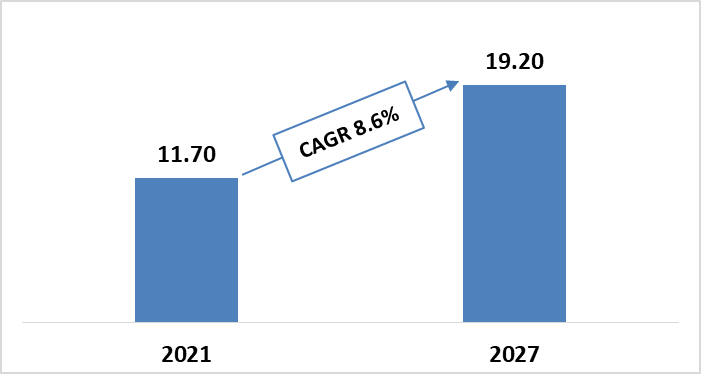
Advantages of Using Distributed Energy Storage System
Significant environmental benefit
Distributed energy storage is an important component of modernizing the energy system as a whole by offering smart grids and related services. There will be significant climate advantages if it is used to increase reliance on renewables. Electric vehicles utilized as distributed energy storage can have a big impact on the environment.
System-level capacity
DESSs add value to the system by deferring or avoiding investment in generation and transmission assets. DESSs’ system capacity value is determined by their utilization capacity during peak load times. When DESSs are utilized to enhance supply or reduce consumption on the grid in place of central generators that would normally be employed in the event of a contingency, such as a forced outage, they provide operating reserve value. (Source)(Source)
Challenges of Distributed Energy Storage System
Expensive setup and battery costs
The upfront cost of distributed energy storage systems is significant, and the ongoing maintenance costs are even higher. Rising pricing of numerous key minerals used in battery manufacture, supply chain disruptions caused by the Russia-Ukraine conflict, and COVID-19 lockdowns in some regions of China have all acted as a barrier to the expansion of the market.
Thermal exhaustion and expensive capital investment
Even though the Distributed Energy Storage industry is quickly expanding, the thermal instability issue of batteries is impeding its expansion. Internal cell faults, mechanical failures or damage, or excess voltage are the primary causes of thermal runaway, which results in high temperatures, gas buildup, and potentially catastrophic rupture of the battery cell, ending in fire or explosion. Aside from that, this market necessitates a substantial capital expenditure to manufacture such a system. As a result, the aforementioned issue will hinder the expansion of this market. (Source)(Source)(Source)
Trend 5: Advanced Lithium-Ion Batteries
Advanced Lithium-Ion Batteries are high-capacity, long-lasting batteries developed for mobile battery stations, electric cars, and electronic devices. A lithium-ion (Li-ion) battery is a high-tech battery that employs lithium ions as an important component of its electrochemical processes. Lithium atoms in the anode are ionized and separated from their electrons during the discharging process.
The modern lithium-ion battery is flexible and ductile. So it can be manufactured in various sizes and shapes to serve a wide range of applications. It has a higher charge capacity and structural stability than standard lithium-ion batteries. (Source)(Source)
In 2021, the global advanced lithium-ion batteries market was valued at $15.03 billion and was expected to increase and reach $112 billion by 2030. During the forecast period, the market will grow at an approximate CAGR of 25%. (Source)
Global Advanced Lithium-Ion Batteries Market Size during 2021-2030 ($Billion)

Advantages of Using Advanced Lithium-Ion Batteries
Improved stability and capacity
Due to the extensive and rising use of portable electronic gadgets, rechargeable, high-energy-density batteries are in high demand. Lithium-ion batteries are widely utilized for their great performance, although they are generally expensive to produce and frequently pose safety issues. A cobalt oxide film is used as an electrode in an improved lithium-ion battery. The film is produced by bacteriophage particles and improves the lithium-ion battery’s durability and capacity. It can be manufactured in various shapes and sizes while maintaining structural integrity.
High energy density
One of the primary benefits of advanced lithium-ion battery technology is its high energy density. With electronic equipment such as mobile phones requiring longer battery life while still consuming more power, batteries with a considerably higher energy density are continuously in demand. Power applications range from power tools to electric cars. The substantially higher power density provided by lithium-ion batteries is a significant advantage for electric vehicles. (Source)(Source)
Challenges of Advanced Lithium-Ion Batteries
Excessive Heating
Batteries are utilized in various applications, including automobiles, electrical systems, and civil airlines. These batteries can store very significant amounts of energy in compact places, but they heat up quickly and may catch fire if something goes wrong with them. Overheating of the batteries can occur due to high-rate discharge or an anomalous discharge rate, such as a short circuit. This phenomenon is called thermal runaway. (Source)
Author’s Note: We dug deeper into the cause of the explosion in Li-Ion batteries and how to prevent it. Here are some solutions we found!
Conclusion
The energy crisis in Europe has affected the continent to a great extent. Its repercussion can be felt in other parts of the world too.
Europe has the alternative of gas for producing energy, such as nuclear plants. But some disasters have made Europe think twice about using nuclear power plants for energy production.
Take Germany, for example. Nuclear power, generated by six power plants, accounted for 13.3% of the German electricity supply in 2021. But they shut down three plants at the end of 2021, with the other three sets to close by the end of 2022, according to the 2011 nuclear phase-out plan.
Nuclear is a good option, but it certainly comes with big disasters like Chernobyl and Fukushima. So, the energy sector needs other options and innovation trends to tackle this crisis and enhance energy storage.
The global market trend of energy storage is growing at a fast pace. (Source) The graph below shows how it will be growing 15-fold by 2030.
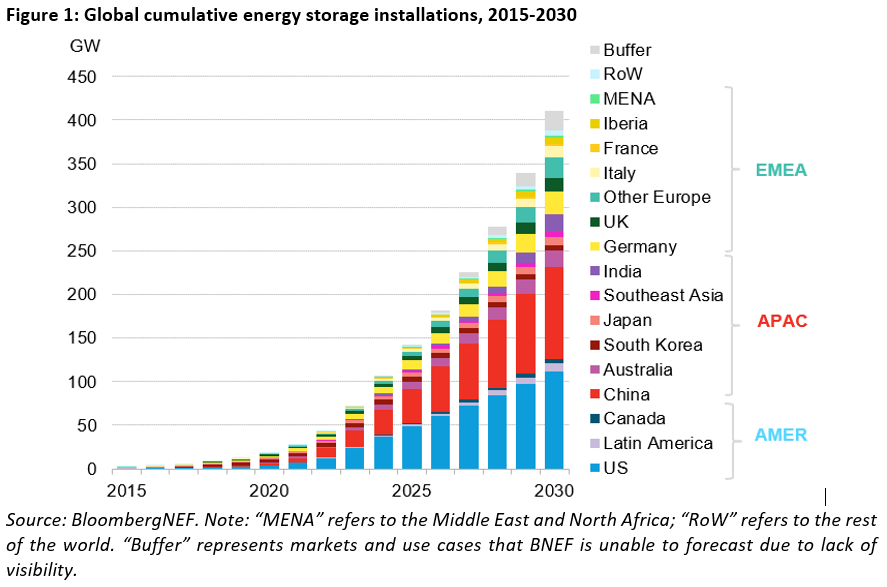
An estimated 387GW/1,143GWh of new energy storage capacity will be added globally from 2022 to 2030 – more than Japan’s entire power generation capacity in 2020. The US and China are set to remain the two largest markets, representing over half of the global storage installations by the end of the decade.
These metrics tell us that the future is bright for the energy storage sectors. However, nothing can be taken for granted. Nature or geopolitical battles can make things worse. So, it’s better for countries and companies to prepare now.
Our complete study discusses the 10 trends in energy storage. These include solid-state batteries, hybrid energy storage systems, smart grids, etc. Fill out the form below to access the complete report:
Authored By: Vipin Singh, Market Research
Edited By: Nidhi, Marketing




